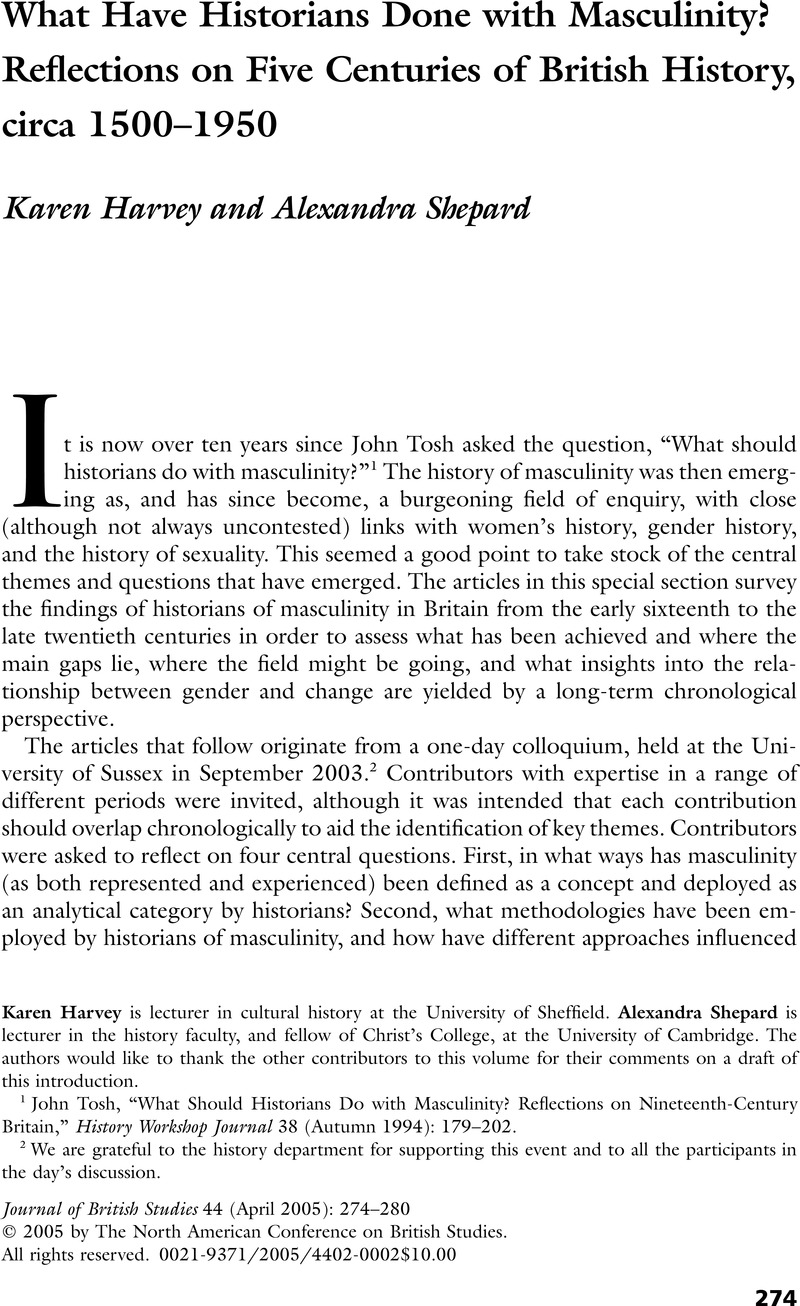Published online by Cambridge University Press: 21 December 2012

1 Tosh, John, “What Should Historians Do with Masculinity? Reflections on Nineteenth-Century Britain,” History Workshop Journal 38 (Autumn 1994): 179–202CrossRefGoogle Scholar.
2 We are grateful to the history department for supporting this event and to all the participants in the day's discussion.
3 Bennett, Judith M., “History That Stands Still: Women's Work in the European Past,” Feminist Studies 14, no. 2 (1988): 269–83CrossRefGoogle Scholar, and “Medieval Women, Modern Women: Across the Great Divide,” in Culture and History, 1350–1600: Essays on English Communities, Identities and Writing, ed. Aers, David (New York, 1992), 146–75Google Scholar; Honeyman, Katrina and Goodman, Jordan, “Women's Work, Gender Conflict, and Labour Markets in Europe, 1500–1900,” Economic History Review 44, no. 4 (1991): 608–28CrossRefGoogle Scholar; Vickery, Amanda, “Golden Age to Separate Spheres? A Review of the Categories and Chronology of English Women's History,” Historical Journal 36, no. 2 (1993): 383–414CrossRefGoogle Scholar.
4 R. W. Connell is alone in having sketched a broad chronological overview of the history of masculinity between 1450 and the present; see his Masculinities (Cambridge, 1995), chap. 8. While recognizing the importance of an ethnographic approach in the formation of the field, Connell has also called for attention to longer-term chronologies. See especially his “Masculinities and Globalization,” Men and Masculinities 1, no. 1 (1998): 3–23CrossRefGoogle Scholar.
5 A similar point is made in Tosh, John, “Hegemonic Masculinity and the History of Gender,” in Masculinities in Politics and War: Gendering Modern History, ed. Dudink, Stefan, Hagemann, Karen, and Tosh, John (Manchester, 2004), 52Google Scholar.
6 Roper, Michael, “Between Manliness and Masculinity: The ‘War Generation’ and Psychology of Fear in Britain, 1914–1950,” Journal of British Studies 44, no. 2 (2005): 343–62CrossRefGoogle Scholar.
7 For a recent exception to this trend, see Dudink, Hagemann, and Tosh, eds., Masculinities in Politics and War.
8 See Purvis, June and Weatherill, Amanda, “Playing the Gender History Game: A Reply to Penelope J. Corfield,” Rethinking History 3, no. 3 (1999): 333–38CrossRefGoogle Scholar.
9 For suggestions that this process predated the early modern period, see also Karras, Ruth Mazo, From Boys to Men: Formations of Masculinity in Late Medieval Europe (Philadelphia, 2003)Google Scholar.
10 For important contributions, see Weeks, Jeffrey, Coming Out: Homosexual Politics in Britain from the Nineteenth Century to the Present (London, 1977)Google Scholar; Bray, Alan, Homosexuality in Renaissance England (London, 1982)Google Scholar, and The Friend (Chicago, 2003)Google Scholar; Trumbach, Randolph, “The Birth of the Queen: Sodomy and the Emergence of Gender Equality in Modern Culture, 1660–1750,” in Hidden From History: Reclaiming the Gay and Lesbian Past, ed. Duberman, Martin. B., Vicinus, Martha, and Chauncey, George, 129–40 (Harmondsworth, 1989)Google Scholar, and “London's Sapphists: From Three Sexes to Four Genders in the Making of Modern Culture,” in Body Guards: The Cultural Politics of Gender Ambiguity, ed. Epstein, Julia and Straub, Kristina, 112–41 (New York, 1991)Google Scholar; Sinfield, Alan, The Wilde Century (London, 1994)Google Scholar; Cook, Matt, London and the Culture of Homosexuality, 1885–1914 (Cambridge, 2003)Google Scholar.
11 The key text is Connell's Masculinities; see also his Gender and Power (London, 1987)Google Scholar.
12 Connell, Masculinities, 77.
13 For a useful discussion of the ways in which historians have deployed the concept, see Tosh, “Hegemonic Masculinity.”
14 Ibid., 48.
15 Tosh, John, “Masculinities in an Industrial Society: Britain, 1800–1914,” Journal of British Studies 44, no. 2 (2005): 330–42CrossRefGoogle Scholar.
16 Connell, Masculinities, 73.
17 Tosh, “What Should Historians Do with Masculinity?” 184.
18 Ibid.